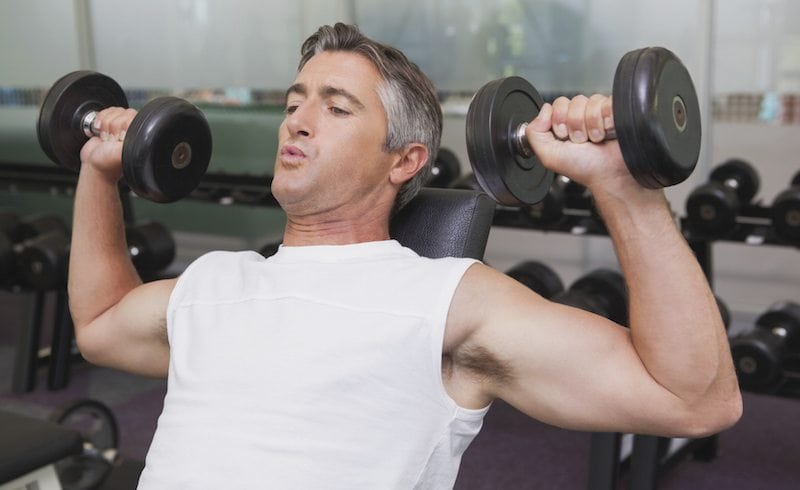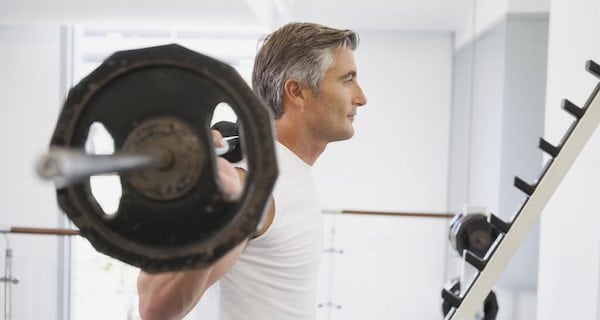No products in the cart.
The Definitive Guide to Building Muscle After 50

Some people believe that there is almost no point in training for strength after you hit 50.
Your testosterone levels are shot, you don’t have the energy, the time, or the desire. Well that’s a load of rubbish!
This article is designed to help you overcome any obstacle in your goal of building muscle, we’ll cover your nutrition, training, hormonal issues, and other lifestyle factors and help you to master all of them.
Remember with good lifestyle choices 50 can be the new 30, or 20.[toc]
A Frank Discussion on Hormones
As you age your testosterone levels will decline steadily, for the longest time people thought that this was just a natural part of ageing.
Now, studies seem to indicate that your testosterone levels are not affected by your age, but by your health and lifestyle.
It’s not that we are dropping testosterone because we are old, but because our health is declining. This means that if you improve your health, or at least maintain it, your testosterone levels should be unaffected.
Granted, it can be more difficult to do this as you age, but it certainly is not impossible.
If you are looking to build muscle you should be expecting to improve your health anyway!
Luckily, there are some simple ways to boost your testosterone back to recommended levels.
You can increase the amount of time you sleep to 8 hours, and look at improving quality through diet, sleeping routines, sleep supplements, and exercise.
You can increase dietary fat (which has been shown to boost testosterone), you can lift heavy free weights, you can take natural testosterone boosting products, you can increase your vitamin D intake, you can even consult a doctor to check your blood levels.
If your level is very low, they may recommend hormonal injections.
Getting your testosterone levels up to a normal level will massively help you increase muscle gain, increase strength, and to burn fat and lose weight.
Nutrition for over 50s

As you are no doubt aware, you can’t build muscle without sufficient protein. If you are under eating your muscles will not be able to increase in size, and could even lose some size (but only in extreme cases).
Helms, Aragon & Fitschen (2014) recommended that natural bodybuilders (which to all intents and purposes you are) should aim for between 2.3-3.1g of protein per kg of lean body mass.
In other words, if you weigh 80kg and are 20% body fat then you have 64kg lean body mass. You would then aim for 2.3 x 64 = 147.2g of protein per day.
To manage this you could consider a whey protein supplement, look for lean protein choices (chicken/turkey breast rather than bacon), and finding vegetarian options is also a great idea.
Greek yoghurt, lentils, chickpeas, kidney beans, etc … are all fantastic sources of protein while having many other benefits besides.
Training for over 50s

You want to build muscle, that much is obvious (otherwise why read this article?). But what do you really want? Did you want bigger muscles (hypertrophy)? Did you want stronger muscles? Or do you just want to look ripped?
These may all sound like different ways of saying the same thing, but they are actually all different.
You can’t successfully train to build bigger muscles, while also looking to remove all body fat.
If you are starting training for the first time in decades then this may be possible, but not long term. So let’s pick one shall we?
As the title of this article is bigger muscles, we’ll create a plan for this.
It used to be a common belief that hypertrophy of the muscles only occurred within a rep range of 8-12 reps.
Any rep range that was lower would only contribute to strength, while any rep range that was higher would lead to muscular endurance and nothing else.
Now it is generally accepted that hypertrophy works best when a varying range of reps is used.
Sometimes you can use lower rep ranges, or medium rep ranges, or even very high rep ranges.
The difference between hypertrophy training and strength training is the goal. In hypertrophy you are looking to create maximal fatigue of the muscles, while strength is all about lifting the heaviest weight that you can.
Hypertrophy training will involve slightly more isolation exercises than strength training, and a higher training volume. So adding in exercises such as leg extensions, bicep curls, tricep pulldowns, and chest flyes.
You can also add in training techniques such as back off sets, drop sets, triple drop sets, and supersets. Just make sure that you don’t overdo it.
Depending on how many days you plan on training per week, you can either follow a full body program (for 2-3 sessions per week), an upper/lower body split (for 4 sessions per week), or body part training program (4-6 sessions per week).
In the example below, we will look at a body part training program:
Sample Training Program
Session One – Chest & Triceps
- Push Ups 3 x AMRAP
- Bench Press 3 x 6-8 + BOS
- Cable Flyes 3 x 12-15
- Dumbbell Skull Crushers 3 x 8-10
- Tricep Extensions 3 x 15 + DS
Session Two – Back & Biceps
- Face Pulls 3 x 12-15
- Pull Ups 3 x AMRAP
- Lat Pulldown 3 x 12-15 + DS
- Bent Over Row 3 x 12
- Barbell Bicep Curls 3 x 8-10
- Dumbbell Hammer Curls 1 x Run The Rack
Session Three – Legs
- Hamstring Curls 3 x 12-15
- Barbell Squats 3 x 8-10
- Leg Press 3 x 12 + DS
- Lunges 4 x 20
- Leg Extensions 3 x 12 + TDS
Session Four – Shoulders & Abs
- Rear Delt Flyes 2 x 15
- Seated Shoulder Press 3 x 8-10 + BOS
- Dumbbell Lateral Raises 3 x 15
- Abdominal Crunches 3 x 20
- Plank 5 x 20 second intense holds
Glossary of Terms
AMRAP = As Many Reps As Possible
BOS = Back Off Sets. Perform the correct number of sets and reps, take a large rest, reduce the weight to 50% and then perform one set of as many reps as you can.
DS = Drop Set. Finish your last set and then immediately (with no rest) reduce the weight to 50% and perform as many reps as you can.
Run The Rack = Place as many different sets of weights as you can in front of you (on a rack if you can), and lift as many reps as you can with the heaviest pair, pick up a lower weight and repeat, then a lower weight still. Repeat until you have run the rack from heavy to light.
TDS = Triple Drop Set. Same as a drop set, but after reducing the weights and performing as many reps as possible, reduce the weight further and repeat one more time.
Lifestyle Factors to Consider
Here are just a few more tips that you can follow to ensure you are in the right state to build muscle. Make sure that you are doing all of the following:
- Sleep 8 hours each night
- Eat more, you need a calorie surplus to build muscle
- If you are very overweight, then concentrate on getting leaner first (calorie deficit) and then you can worry about muscle building
- Schedule rest days in between your sessions to allow adequate recovery time
- Supplement with fish oils, vitamins, glucosamine, and other supplements that can help older men survive the rigours of training hard
Hopefully, having read the above you will have a better idea of how to build muscle after 50. Good luck!
